Teaching Your Homeschool Kids Responsibility And Independence With The Flexible Homeschool App
If there is one thing we want our kids to be when you are a working mom, it is to be responsible and independent.
As homeschool moms, we hear all the time that homeschool kids are soooo independent! Of course, we want our children to learn independence, learn how to work on their own, and, as they get older, take responsibility for their education.
But how do we get from here to there? How do we teach our homeschool kids responsibility and independence? And how do we find the time to help them practice independence?
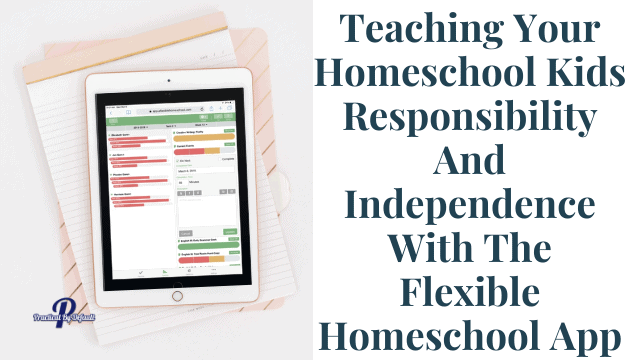
What Is Independent Learning?
When you picture your kids taking responsibility and being independent in your homeschool, what does that look like to you?
This is important because you need to have a clear idea of what “responsibility and independence” will look like for your family.
Does it look like your younger child picking up a book and reading on their own? Does it look like your middle child doing a math lesson without being told? Does it look like your high schooler working through all of their assignments without you?
The truth is, independence in your homeschool looks different at every age and stage.
However, the idea behind having a child learn independently means that the child will take full responsibility for their learning.
Independent learning also allows for more personalized education for the kids. They can more easily follow their own interests when working on their own at least part of the day.
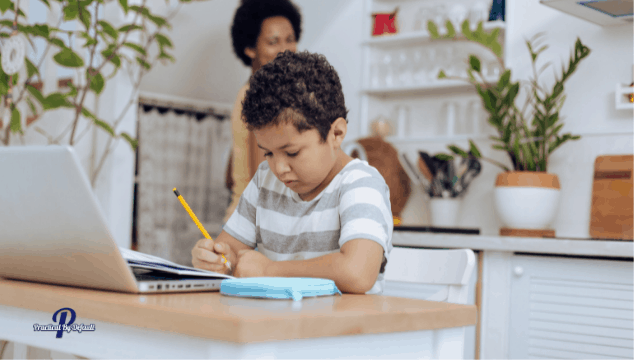
Why Teach Your Homeschool Kids To Be Independent Learners?
As a working mom who is homeschooling, I quickly learned I could not do all the things at the same time. I could not teach all the subjects in my homeschool, work several jobs both inside and outside the home, handle the housekeeping and meal making and, and, and…and remain sane.
It was going to take more than coffee to make this lifestyle work and be sustainable.
Teaching your kids responsibility and independence will make your life easier, and as a working mom, I would label raising independent learners as vital.
Having independent learners is critical for a working mom because you need time to work. This doesn’t make you a bad mom or a bad homeschool mom to encourage independent learning.
Who doesn’t want kids that dive into their homeschool work when you are on a business call? Or to be able to complete homeschool assignments while you are at the office? Or have your kids bombard you with all the awesome facts about the world they discovered at the sitters that day?
As a parent, it is part of our job to prepare our kids for life, and that means giving them the skills to succeed including learning to be independent in all situations.
You can have independent homeschoolers, but it is a learned skill that you need to teach them.

How To Teach Your Kids Independent Homeschoolers
Before I reveal the tips and tools I used to teach my kids to be responsible and independent learners, I want to remind you that every child is different.
Some children are ready to take charge and work on their own at a younger age. They crave responsibility, gleefully being in control of what they do and when. (And likely bossing their siblings around, hehe). You can show them a task, and they will show you on your way to dig in.
Other children may not be ready for you to step away and need more time to make the switch. They want your attention, and quickly being overwhelmed by being alone with a task. You may need to ease them into working on their own over time slowly.
Remember: Homeschooling is a marathon, not a race. Teach the child you have and adjust your expectations as needed. Change is hard for most of us. Kids are no exception.
5 Ways to Teach Independent Learning in Your Homeschool
1. Start with something familiar
When I first started teaching my kids to be independent learners, I started slow, with a program they knew.
Begin with explaining the assignment and answering any questions they may have. You don’t want to overwhelm your child, so keep it short and straightforward. Doable.
The goal is to empower your child and build their confidence. Now is not the time to introduce a new skill.
While I am all for letting our kids dive into new things, learn, try and fail, I recommend saving that for after your kids are comfortable learning independently and taking responsibility.

2. Set clear expectations
When you work and homeschool, you must have clear communication and expectations for routines and systems to work. Teaching your kids to be independent is no different. They need to know what is expected of them.
Again, start small. Then build on that progress.
Answer this one question.
Read this paragraph.
Complete one worksheet.
Eventually, you will be able to give them more responsibility.
3. Create a plan for when they need help.
Your children are going to get stuck and need help. Learning new things is hard. Even if your child can perfectly complete the task you’ve asked them to do, it doesn’t mean they won’t get distracted or forget how to do something.
Have a clear plan so that your child knows what to do when stuck and how to get unstuck!
The plan in our homeschool changed over the years, but here are some examples:
- Read the question out loud
- Re-read the paragraph or re-watch the video and try again.
- Look for hints or tips in the material on what to do
- Ask your sibling for help
- Set it aside and move on to a different task
Don’t forget to work with each child and the circumstances. For example, one of my children struggled with math big time. She often did her math assignments while I was at work, and there was no way for me to help her on the spot.
Our plan for her was to re-watch the video lessons CTCMath provided and try again. If she was still stuck, she could print off the worksheet and ask her brother for help. If after 30 minutes she was still stuck, she was to set it aside, and we would chat on my break.
4. Give them space and time
One of the joys of homeschooling is learning side by side with your child. But if you want your kids to learn on their own, they need space and time.
Again, start small both in distance and time.
I started by asking my son to work on a task while I checked on his baby sister at the other end of the table. Physical space was under 4 feet away, time 5 minutes. Enough time to complete the task, but I was still in his line of sight.
Over time, I increased both time and distance.
At the kitchen sink to do dishes for 15 minutes.
Folding laundry in the living room for 30 minutes.
Playing with the dog for 20 minutes outside while he was at the table.
Slowly moving all the way up to going to work for several hours while he worked on tasks at the sitter’s. Right now, it may feel like you are never going to get there, but you will.
Teaching independence in your homeschool takes time, effort, patience, and the right tools.
5. Keep a system of accountability in place.
The last piece of the puzzle is using the right tools.
As working moms, we know the value of having a task list or a to-do list to keep us on track and help us remember what needs to be done.
Once your child is ready to complete more than one task, it is time to give them the tools to succeed.
Using a checklist is a great system for the kids to see what needs to be done and have the satisfaction of checking things off!
When my kids were younger, they loved these tear-away checklists. As they got older, they moved on to printable planners, printed planners, and even digital tools to stay on track.

What Is The Best Tool For Your Child?
One of the most important parts of teaching your kids to be responsible and independent is arming them with the right tools.
When my children were younger, I preferred to use paper. You can start with pictures for non-readers or new readers to see what to do next and check it off.
For example, you might use a drawing of a headset and a book to remind them to listen to an audiobook.
As they get older, use tools that empower them and give them confidence.
I’ve talked about using the Flexible Homeschool app as an excellent way for moms to track their homeschool (read that here). Now let’s dig into using the same app to empower our kids and encourage them to be responsible and independent.
While this article is sponsored by the Flexible Homeschool app, all thoughts and opinions are mine.
How The Flexible Homeschool App Can Help
Flexible Homeschool App is a web scheduling app for homeschoolers that can be accessed on any internet-connected device (so long as it’s not ancient).
It is designed to help you plan and track your family’s homeschool progress, which in turn makes it a great tool for teaching your kids to be independent.
If you are not familiar with the Flexible Homeschool App, please read my review here and learn more, including how to set it up for your child.
Once you have it set up, your child can log in to their account and see the assignments for the day. After you are logged into your account, it will automatically bring you to the tracking page.
Using The Flexible Homeschool App To Teach Responsibility And Independence
The great thing about the Flexible Homeschool App is that your child can take ownership of their homeschool.
Your child learns responsibility when they check their schoolwork for the day. They can check on what to do in the “Info box” in the Tracking view.
They can also check the Notes Tab for more information or links, as shown here.
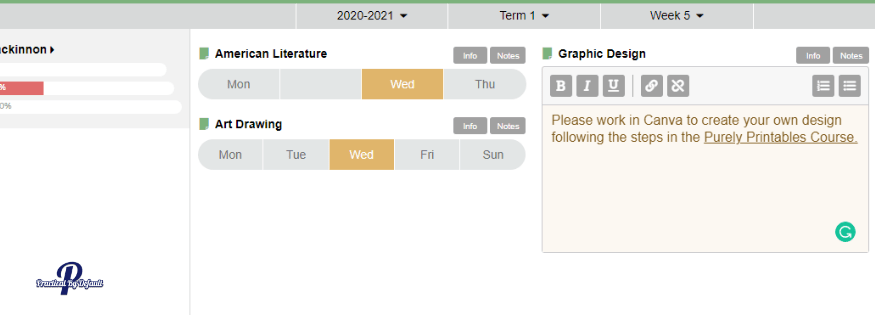
Make sure to tell your child that if the Notes are Yellow, this indicates you have made a special note for that week.
Of course, you can always use the printable checklist instead of the digital app.
As your child completes assignments, they can check them off the list using the “complete” checkbox. If your child uses the app, the assignment will turn from orange to red when marked complete.

And when the entire week or day’s assignments are done, the blocks all turn green! You know that satisfaction you get from checking off your entire checklist?
Your child will feel the same feeling comes when they see all that green! Especially when the sidebars showing percentages move forward and/or turn green to show a completed week, term, or year.

How To Find The Time To Teach Responsibility And Independence In Your Homeschool
Teaching our kids a new skill takes time and patience.
Here are a few tips you can use to help you find the time to teach independence:
- Choose a time in your day when you have more patience and energy.
I would avoid trying to teach a new skill after a long day of working or dealing with stressful situations.
2. Plan for the activity to take at least twice as long as normal.
For example, if your child does a math question in 10 minutes, give them at least 15-20 minutes. This allows your child the time to figure out what to do without stressing you out about being late for work, an appointment, etc.
3. Plan ahead.
When you complete your weekly planning session, decide what day you will help your child practice independence. Then, write it in your planner.
4. Be flexible.
Just because it is written in your planner doesn’t mean it is written in stone. If your child is having a particularly hard day and needs one-on-one time, now is not the time to try to teach them to be independent.
If you had a run-in with your boss or a client ended up being “one of those clients,” push practicing independence with your child off to another day.
Remember, your goal is to build their confidence that they can do hard things. You know your kids and yourself best. I trust that you know when to push through and when to back off. There is NO guilt in moving things to another day. That’s the freedom and flexibility we love about homeschooling.
Make it work for you mama!
You Can Teach Your Homeschool Kids Responsibility And Independence
As a working mom, teaching independence in your homeschool is a must because you really can’t do all the things at the same time.
Remember: As a parent, it is part of our job to prepare our kids for life, and that means giving them the skills they need to succeed, including learning to be independent.
You can do it if you:
- Start with something familiar
- Set clear expectations
- Create a plan for when they need help
- Give them space and time
- Keep a system of accountability in place
Teaching your homeschool kids to be responsible and independent will help save you time and reduce the amount of stress you feel each day. And it just might save your sanity!
If you are looking for a great online tool, I highly recommend checking out the Flexible Homeschool App.
📌Don’t let this post get lost in the internet abyss – pin it to your Pinterest board now!


Hi, I’m Jen. I help working moms juggle their career and homeschool their kids by providing support, systems and tools. You are warmly invited to Join the Online Community Here!






